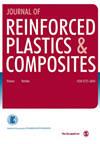有限变形下单向纤维增强复合材料的模型预测
IF 2.2
3区 材料科学
Q3 MATERIALS SCIENCE, COMPOSITES
引用次数: 0
摘要
直观的认识是,单向纤维增强复合材料(UD-FRP)的机械模量随着纤维取向角的增大而减小。然而,本研究的数值结果和以往文献中的实验结果表明,UD-FRP 的机械响应与纤维取向角呈 U 型关系。为了解释这一现象,我们建立了一个各向异性模型来捕捉 UD-FRP 的力学行为。应变能被分解为四个部分:基体、纤维、纤维-基体法向和剪切相互作用。每个分量都可以通过匹配离轴 0°、45° 和 90°的单元格的机械响应来确定。该模型得出的结果与偏离轴线 15°、30°、60° 和 75°的单元格的数值响应十分吻合。随着纤维取向角的增大,基体部分保持不变,纤维分量减小,但纤维-基体法向分量增大,纤维-基体剪切分量先增大后减小。应变能贡献的变化解释了机械响应与纤维取向角呈 U 型关系的机理。本文章由计算机程序翻译,如有差异,请以英文原文为准。
Model prediction of unidirectional fiber-reinforced composites under finite deformation
The intuitive knowledge is that the mechanical modulus of unidirectional fiber-reinforced composites (UD-FRPs) decreases with higher fiber orientation angles. However, numerical results in this work and experimental results in previous literature indicate that the mechanical response of UD-FRPs has a U-shaped dependence on fiber orientation angle. To explain this phenomenon, we develop an anisotropic model to capture the mechanical behavior of UD-FRPs. The strain energy is decomposed into four components: matrix, fiber, fiber-matrix normal, and shear interactions. Each component can be determined by matching the mechanical responses of unit cells with 0°, 45°, and 90° off-axis. The results obtained from the presented model match well with the numerical response of unit cells with 15°, 30°, 60°, and 75° off-axis. With an increasing fiber orientation angle, the matrix part remains unchanged, the fiber component decreases, but the fiber-matrix normal component increases, and the fiber-matrix shear component increases and then decreases. The change in strain energy contributions explains the mechanism of the U-shaped dependence of the mechanical response on fiber orientation angle.
求助全文
通过发布文献求助,成功后即可免费获取论文全文。
去求助
来源期刊

Journal of Reinforced Plastics and Composites
工程技术-材料科学:复合
CiteScore
5.40
自引率
6.50%
发文量
82
审稿时长
1.3 months
期刊介绍:
The Journal of Reinforced Plastics and Composites is a fully peer-reviewed international journal that publishes original research and review articles on a broad range of today''s reinforced plastics and composites including areas in:
Constituent materials: matrix materials, reinforcements and coatings.
Properties and performance: The results of testing, predictive models, and in-service evaluation of a wide range of materials are published, providing the reader with extensive properties data for reference.
Analysis and design: Frequency reports on these subjects inform the reader of analytical techniques, design processes and the many design options available in materials composition.
Processing and fabrication: There is increased interest among materials engineers in cost-effective processing.
Applications: Reports on new materials R&D are often related to the service requirements of specific application areas, such as automotive, marine, construction and aviation.
Reports on special topics are regularly included such as recycling, environmental effects, novel materials, computer-aided design, predictive modelling, and "smart" composite materials.
"The articles in the Journal of Reinforced Plastics and Products are must reading for engineers in industry and for researchers working on leading edge problems" Professor Emeritus Stephen W Tsai National Sun Yat-sen University, Taiwan
This journal is a member of the Committee on Publication Ethics (COPE).
 求助内容:
求助内容: 应助结果提醒方式:
应助结果提醒方式:


